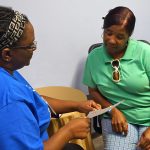Loyola Lead Pathologist Reflects on Fourth See, Test & Treat
In 2015, Loyola University Medical Center became the site of the first See, Test & Treat program in Illinois, the CAP’s home state. On Saturday, September 8, Loyola hosted its fourth See, Test & Treat, serving a diverse population including Hispanic, Polish, and Turkish patients. To mark the occasion, CAP Foundation staff sat down with the lead pathologist who started it all: Dr. Eva Wojcik. She opened up about See, Test & Treat, women’s access to health care, and Loyola’s journey to this point.
Q: Tell us a bit about your background and how it motivated you to get involved in See, Test & Treat. How does it help you relate to patients?
A: I was born in Poland, I finished my medical school back in Poland, and I came here to do my residency. My whole pathology career has taken place here in the United States. Of course, I speak Polish very well, and I have many Polish friends, and I do understand that many of them have problems with obtaining appropriate care. And this does not apply only to the Polish community but also to other communities in the same situation right now. Therefore, this program is really excellent for people who don’t have means yet to get appropriate care.
Q: This is now the fourth See, Test & Treat at Loyola—congratulations! How did you go about getting the program up and running?
A: When I decided to potentially start this program at Loyola, I reached out to the senior leadership because I understood that this was going to be a very significant effort on multiple fronts. For that, I had to have the agreement and blessing, more or less, from the senior leadership, who truly believed in the overall mission of the program. Having this [agreement] from the beginning, it was much easier to find the volunteers, and find the people who would work on the logistics of it all.
Q: What challenges have cropped up along the way?
A: The challenge sometimes is the collaboration and cooperation with the media [outside of Loyola] to spread the news. This year, we relied extensively on social media, both through official Loyola sites, but also all our individual accounts as well to spread the information to the community as much as possible.
Q: What has the Loyola team gained out of hosting this program?
A: It has been very educational to all of us because of all the preparation. I personally learned a lot in regard to how health care operates, how the hospital operates. We have to think about the security, janitors, cleaning … on up to the providers—who’s going to be reading mammograms, who’s going to see the patients. Practically each and every area and section of this entire medical center has been involved.
Q: What are one or two patient success stories that stand out to you from Loyola’s collection of See, Test & Treat events?
A: Frankly speaking, I look at each and every patient who passes through this program as a success story. I still remember tears in patients’ eyes when they learn that indeed everything is fine. I remember asking one patient, “When was the last time you had a Pap test?” She turned to her daughter and asked, “How old is Jimmy?” Her daughter told her 19, and she said, “Oh, so it must be 19 years ago.”
Each and every woman who crosses this door is afraid that we are going to find something because they either have never been tested in their life, or it was such a long time ago. So to see relief in their eyes is truly priceless.
Q: What kind of health care lessons or education do you hope women gain by attending a See, Test and Treat?
A: I think the most important lesson is for all these women to realize that this is their right, to have this testing done. And if this is their right, there are means. Sometimes it’s going to be more difficult, but there are means for them to obtain these tests.
Q: What would you tell a woman who’s on the fence about coming to a See, Test & Treat?
A: In this time, no woman should die of cervical cancer, or even breast cancer. I think everyone understands that the best prevention is an early detection. And that’s the main purpose of the regular screenings.
Again, this is their right, to have those tests done. And I would even say this is their obligation—to their own family, to their children—to take care of themselves.


